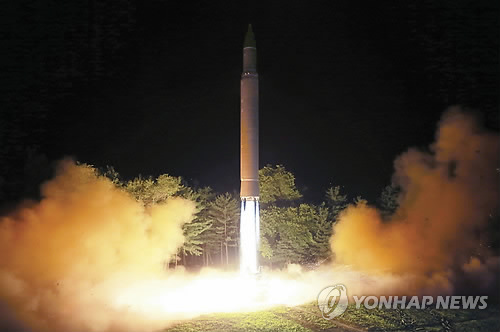North Korea launched at least three missiles into the East Sea on Saturday morning, resuming its provocative acts after a monthlong hiatus despite Washington's diplomacy-first approach toward the belligerent regime.
The North fired "several unidentified projectiles" from the vicinity of Gitdaeryong in Gangwon Province starting at around 6:49 a.m., said South Korea's Joint Chiefs of Staff. Those flew more than 250 kilometers in a northeastern direction, it added.
Gitdaeryong, located near the eastern city of Wonsan, is home to the North's key missile base.

Cheong Wa Dae, the South Korean presidential office, convened a National Security Council (NSC) meeting.
The office said that the projectiles are believed to be artillery rockets from a multiple-rocket launcher, while the U.S. military reaffirmed its assessment characterizing those as short-range ballistic missiles.

"As of now, the unidentified projectiles fired by the North today are presumed to be improved 300-mm artillery rockets from a multiple-rocket launcher," Yoon Young-chan, senior presidential secretary for public relations, said in a statement issued after the NSC session.
However, the U.S. Pacific Command said the projectiles were apparently ballistic missiles.
They were "SRBMs," PACOM's spokesman Cdr. David Benham said in an emailed reply to Yonhap News Agency's query, using the acronym for short-range ballistic missiles.
The Hawaii-based command also revised its initial assessment of the North's latest missile test.
"As an update to our initial release, the first and third missiles at 11:49 a.m. (Hawaii time) and 12:19 p.m. did not 'fail in flight,'" Benham said in a separate statement. "Rather, they flew approximately 250 kilometers in a northeastern direction. We will continue to work with our interagency partners on a more detailed assessment of this latest launch and we will provide a public update if warranted."
In the previous release, PACOM said the first and third missiles failed in flight, with the second having blown up "almost immediately."
The launches came a month after the communist nation test-fired another intercontinental ballistic missile.
An annual South Korea-U.S. combined military drill, called Ulchi Freedom Guardian (UFG), is underway on the peninsula.
Although the allies said the command-post practice, largely a war game, is defensive in nature, Pyongyang has long claimed that it's an invasion rehearsal.
The North has often used such a military exercise by the allies as a pretext for provocations.
Cheong Wa Dae announced that the allies won't be swayed by the North's saber-rattling, saying they will "proceed more thoroughly" with the ongoing UFG drills.
The White House said President Donald Trump has also received a briefing on the North's missile firing.
"In regards to activity in North Korea tonight the President has been briefed and we are monitoring the situation," its press secretary Sarah Huckabee Sanders said.

The North's move threw cold water on burgeoning expectations for momentum in efforts to ease tensions on the peninsula.
On Tuesday, U.S. Secretary of State Rex Tillerson openly said in Washington, "I am pleased to see that the regime in Pyongyang has certainly demonstrated some level of restraint that we've not seen in the past."
He expressed hope for dialogue with Pyongyang.
Trump also voiced cautious optimism when talking about the North's leader Kim Jong-un.
"I respect the fact that he is starting to respect us," Trump said at a campaign rally earlier this week. "And maybe -- probably not, but maybe -- something positive can come about."
The North earlier threatened to shoot four intermediate-range ballistic missiles toward the U.S. territory of Guam. (Yonhap)

